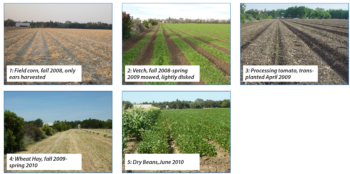Tipsheet: Crop Rotation in Organic Farming Systems
By Rex Dufour, NCAT Agriculture Specialist

This organic farmer uses a very diverse rotation, which supports weed and insect control, and soil health. The rotation will vary depending on prices and water availability. Included in this rotation in subsequent years are alfalfa (3 years). Photos: Rex Dufour, NCAT
Why Crop Rotation?
Crop rotation, planting a different crop on a particular piece of land each growing season, is required in organic crop production because it is such a useful tool in preventing soil diseases, insect pests, weed problems, and for building healthy soils. Plants exude a spectrum of photosynthates into the soil that are unique to each plant species, and these root exudates influence the soil microbial biodiversity, which, in turn, supports soil function and plant health. Crop rotations must fit with the farm’s production system, equipment, labor, and market demand for the farm’s crops. With so many variables to consider, developing a good plan is as much an art as it is a science. It is important to develop a plan for bed preparation that includes row-spacing considerations for future rotations, because this will increase crop rotation options and reduce labor.
General Principles to Guide Crop Rotations:
Adapted from Building Soils for Better Crops (2000; Fred Magdoff and Harold van Es), chapter 11, “Crop Rotation,” pp. 102–3:
- Follow a legume crop…with a high-nitrogen-demanding crop.
- Grow less-nitrogen-demanding crops…in the second or third year after a legume sod.
- Grow annual crops for only one year in a particular location…
- Don’t follow one crop with another closely related species…
- Use crop sequences that promote healthier crops.
- Use crop sequences that aid in controlling weeds.
- Use longer periods of perennial crops on sloping land.
- Try to grow a deep-rooted crop…as part of the rotation.
- Grow some crops that will leave a significant amount of residue.
- When growing a wide mix of crops…try grouping into blocks according to plant family, timing of crops, (all early season crops together, for example), type of crop (root vs. fruit vs. leaf), nutrient needs, or crops with similar cultural practices.
USDA Organic Regulations Relating to Crop Rotation Standards
7 CFR §205.205 Crop rotation practice standard.
The producer must implement a crop rotation including but not limited to sod, cover crops, green manure crops, and catch crops that provide the following functions that are applicable to the operation:
(a) Maintain or improve soil organic matter content;
(b) Provide for pest management in annual and perennial crops;
(c) Manage deficient or excess plant nutrients; and
(d) Provide erosion control.
§205.203 Soil fertility and crop nutrient management practice standard.
(b) The producer must manage crop nutrients and soil fertility through rotations, cover crops, and the application of plant and animal materials.
§205.206 Crop pest, weed, and disease management practice standard.
(a) The producer must use management practices to prevent crop pests, weeds, and diseases including but not limited to:
- (1) Crop rotation and soil and crop nutrient management practices, as provided for in §§205.203 and 205.205;
Common Plant Families of Crops |
|
Plant Family |
Crops in Plant Family |
| Grasses | Corn, barley, wheat, oats, millet, spelt, rye, sorghum, sudex |
| Legumes | Peas, beans, vetch, clover, alfalfa |
| Mustards/Brassicas | Broccoli, cauliflower, Brussels sprouts, collards, kale, kohlrabi, cabbage, Chinese cabbage, turnips, mustard greens, canola, radish, various mustard cover crops, sweet alyssum, arugula |
| Alliums | Garlic, leeks, onions, chives, shallots |
| Cucurbits | Squash, pumpkin, cucumbers, gourds, melons |
| Solanaceae/Nightshade | Tomato, potato, eggplant, peppers, Goji berries, tobacco |
| Lettuce/Asteraceae | Lettuce, endive, artichokes, safflower, sunflower |
| Beets/Chenopodiaceae | Beets, spinach, Swiss chard, chard |
| Carrot/Apiaceae | Anise, arracacha, asafoetida, caraway, carrot, celery, coriander (cilantro), cumin, dill, fennel, hemlock, parsley, parsnip |
| Rosacea | Strawberries |
Crop Rotation Planning Steps
The following steps are adapted from Crop Rotations on Organic Farms (Mohler and Johnson, 2009):
- Identify and prioritize your goals for the crop rotation (e.g., organic compliance, weed control, disease control, soil quality)
- List your crop mix
- Check for excessive acreage in one family
- Identify crop couplets and short sequences that work on your farm (including cover crops),
- Make a crop-rotation planning map, noting which beds or fields (or parts of fields) are problem areas that might affect certain crops.
It is important to keep in mind that the ideal plan is flexible enough to respond to changing economic and weather conditions while at the same time maintaining the health of your soil and the economic health of your farm. Diversified operations growing many different kinds of crops should focus on good crop sequencing, which requires accurate records of crops grown in each bed or field.
Considerations for Rotating with Cover Crops
Selection of cover crops will depend on the goals of the farmer, which may include providing biological N, biomass, insect habitat, weed management, erosion protection, or combinations of these. Species selection will also depend on when the cover is planted—cool season or warm season. How the cover crop will be terminated should be part of the planning process as well. One creative and inexpensive way to transition conventional ground to organic production is to allow a year 1 cover crop planted with organic seed to go to seed so a second cover crop can be grown with little seed cost. The first year cover crop can be rolled in the fall, and will provide an excellent mulch for the second year’s cover crop, in addition to providing free seeds. Depending on the goals of the farmer, the second year’s cover crop can be disked, rolled, or even harvested. In order to qualify as organic, any subsequent cash crops planted into this system will require a full three years from the time of application of the last prohibited substance to the time of harvest for the cash crop (the cash crop can be planted prior to the full three years’ transition, but must be harvested after the three-year transitional time frame).
Perennial Crops and Crop Rotation
Clearly, crop rotation will not be applicable to perennial systems. However, rotating cover crops in the alleys between perennial crops represents an opportunity to increase the biodiversity of perennial systems and protect against pest buildups. There are several options related to alley cover crops: they can be rotated annually to a different cover crop, or mix of cover crops, or every other alley can be planted to cover crops, leaving alternate alleys bare. Some farmers believe this practice can provide some level of frost protection because bare ground will absorb and give off more heat. Also, some farmers will plant different cover crops every other alley and each year “switch” the alley cover crops.
References
Magdoff, Fred, and Harold van Es. 2000. Building Soils for Better Crops. 3rd ed. SARE. p. 102–3.
Mohler, C.L., and S.E. Johnson (eds.). 2009. Crop Rotations on Organic Farms: A Planning Manual. Natural Resource, Agriculture and Engineering Service.
Resources
Crop Rotations on Organic Farms: A Planning Manual. 2009. Edited by C.L. Mohler & S.E. Johnson. Natural Resource, Agriculture and Engineering Service.
Market Farming with Rotations and Cover Crops: An Organic Bio-Extensive System. 2015. By George Kuepper. Kerr Center for Sustainable Agriculture, Poteau, OK.
Managing Cover Crops Profitably, 3rd Edition. 2007. Edited by Andy Clark. SARE Handbook Series, book 9.
USDA Organic Regulations 7 CFR 205
USDA National Organic Program Handbook
- NOP 5029: Guidance – Seeds, Annual Seedlings, and Planting Stock in Organic Crop Production
- NOP 2602: Recordkeeping of Certified Organic Operations
- NOP 2615: Organic Systems Plans, Organic Systems Plans Updates and Notification of Changes
- USDA NOP Organic Crop Documentation Forms
USDA National List of Allowed and Prohibited Substances
Tipsheet: Crop Rotation in Organic Farming Systems
© 2015 National Center for Appropriate Technology—NCAT
By Rex Dufour, NCAT Agriculture Specialist
IP407
This publication is produced by the National Center for Appropriate Technology through the ATTRA Sustainable Agriculture program, under a cooperative agreement with USDA Rural Development. This publication was also made possible in part by funding from the U.S. Department of Agriculture’s Agricultural Marketing Service, National Organic Program. ATTRA.NCAT.ORG.


